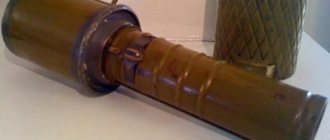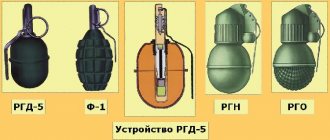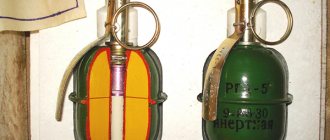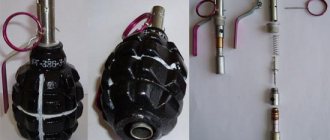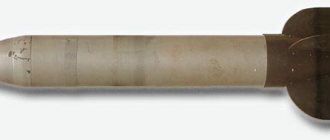The RGD 33 hand grenade is a remote-type anti-personnel fragmentation grenade that was widely used by Soviet troops in the early years of the Great Patriotic War. Its main destructive element was fragments. An interesting feature of this grenade was that it could be used as either an offensive or defensive grenade. The regulations of that time even described how to use the RGD 33 in the fight against enemy tanks and firing points.
The RGD 33 grenade belonged to the double type of grenade. It had a special casing with notches, which was used when using a grenade in defense. It was easy to put on a grenade and, when detonated, produced a large number of fragments. When a grenade with a protective casing was put on it exploded, more than 2,000 fragments were formed.
History of the creation of RGD-33
The grenade is the brainchild of the famous Soviet designer Mikhail Grigorievich Dyakonov, which is reflected in its name.
He began his activities as a weapons creator during the First World War. And it was he who was entrusted in the mid-20s with the modernization of the Rdtulovsky grenade of the 1914 model, already outdated at that time.
For 4 years, from 1925 to 1929, the designer experimented with various designs and at the end of the 29th year he presented his model, which was put into service in 1930.
The projectile receives the designation RG-1914/30.
However, Dyakonov himself is not entirely satisfied with his work and continues his research. Their result is a new grenade, which will become known as RGD-33.
The main difference from the previous version was the increase in the thickness of the body, which made it possible to increase the number of fragments obtained when it was detonated.
Also, the increase in its lethality was facilitated by the decision to place a segmented metal tape, rolled in several layers, under the outer shell - this was also reflected in the number of damaging parts.
The system for bringing the grenade into a combat-ready position has also undergone modernization. It has become a little more complicated, but at the same time more reliable.
In 1933 it was adopted by the Red Army and soon became a mandatory part of the equipment of infantry and motorized rifle military units.
Hitting the target
To throw the RGD-5 grenade, you must first remove the safety pin. In this case, the lever is pressed tightly against the body of the combat equipment and is held until the moment of throwing. Next, the spring is activated. She turns the safety lever, releasing the firing pin. That, in turn, under the influence of a spring interacts with the igniter primer. The flame spark from it goes to the moderator, and then, after complete burnout, to the detonator charge. This leads to the grenade exploding.
The final weight of the RGD-5 grenade is 315 g. This small mass allows soldiers to throw a unit at a distance of 50 to 60 meters.
To throw a grenade, you need to go through several stages:
- to begin with, you should take the projectile in your hand so that the safety lever is closely adjacent to the body;
- then you need to unclench the “antennae” of the checks;
- pull it out of the fuse and throw the RGD-5 at the intended target.
Description and design of the grenade
The grenade consists of three main parts:
- a housing containing explosive and fragmentation material;
- a handle equipped with a hammer mechanism and a spring;
- a fuse that acts as a detonator.
To avoid contamination of the detonator socket or the entry of foreign objects into it, it was closed with a special valve. In the initial models it moved to the side, in later ones it was replaced with a rotary one.
The lower part of the body had a special protrusion with a thread into which the handle was screwed. There was also a special ring with jagged edges that prevented the handle from unscrewing after installation. That is why they were wound up immediately before the fight.
The RGD-33 grenade is offensive-defensive. Its versatility was achieved by the presence of a special casing, which was put on the body when using the projectile in defense mode.
The casing made it possible to increase the number of fragments and the radius of their destruction, for which it had diagonal intersecting notches.
Two types of such improvement were used - lightweight and regular. The first weighed 125g, the second - 250g. The weight of the grenade without casing was almost 500g.
When using the projectile in offensive mode, the destructive power of the fragments was maintained within a radius of 5-10 meters from the epicenter of the explosion. When installing the casing, this parameter was already 30-35m. That is why throwing in this form was recommended exclusively from cover or a trench.
The grenade came to the troops exclusively in a disassembled state: the body separately, the handles separately, the fuses, respectively, separately. The soldiers received them in the same form.
The projectile was assembled immediately before the battle, but not completely - only the handle was installed. The installation of the fuse was carried out already in battle, before the throw or at the stage of preparation for it.
The sequence of actions was as follows:
- Insert the fuse and put the grenade on safety.
- Charge the spring by pulling and turning the handle.
- Remove the safety and throw it at the target.
When canceling the throw, that is, excluding the third point, the reverse sequence was performed.
The swing during the throw activated the striker, thanks to which the detonator capsule was pierced, and this was followed by an explosion. The detonation mechanism had a retarder, as a result of which the detonation occurred 3.5-4 seconds after the throw.
On average, a grenade was thrown 30-35 meters.
Where to wear it?
In conditions close to combat, each soldier has RGD-5 grenades in his ammunition. In this case, the case itself is stored in a special bag. The fuses, each wrapped in paper or cloth, are located there, but separate from the grenades. Previously, a soldier had to carry a canvas bag with two pockets for fuses and a compartment for two combat units. Currently, the military prefers to carry grenades and components in the pockets of their vests.
In tracked or wheeled combat vehicles (infantry fighting vehicles, self-propelled artillery, tanks, armored personnel carriers), grenades and fuses are stored separately from each other in different bags.
Modifications of RGD-33
During the period from 1938 to 1942, several attempts were made to modernize the grenade. One of the first such experiments was the creation of the 57-G-713 projectile.
The designers proposed using the body of a serially produced product, but using a handle of a different design. This product also had a striking mechanism, which, together with other claims, did not allow it to be adopted for service - the modified structure of the handle did not seem to be a significant modernization.
In 1941, due to the need to simplify the production of grenades, a project was developed to supply the projectile with a different igniter.
However, the project was not approved and did not go into production - with such “modifications” the product became very unreliable when transporting and carrying when assembled.
In 1942, a new explosive mixture was being developed for the RGD-33, which would increase its destructive power. However, by the end of them, there had already been a transition to the use of new grenades, where the improvements came in handy.
Also in 1942, a special device for throwing the RGD-33 was created, which significantly increased its throwing range and flight speed.
The tests were successful, and it was planned to produce about 2000 of these devices. However, the refusal to use the grenade put an end to these plans.
Training option
To master the RGD-5 and throw it precisely at the target, men initially undergo special training. In schools, in educational institutions for secondary and secondary special purposes, in universities with a military department, military schools and, of course, the army, young people are trained to use a non-combat version of the grenade, which is called the “URG-N training and simulation grenade.”
Like RGD-5, this prototype has exactly the same appearance, shape, and weight. The URG-N grenade also does not differ from the combat version in terms of handling rules. The process of contact of the training analogue with the surface during throwing is accompanied by sound and visual effects: smoke, roar, etc. The methodological analogue URG-N is used many times. This grenade, like its combat “brother,” consists of a body and a fuse. The latter is an imitation of the real version. The hulls of the URG-N and RGD-5 are almost identical. The only difference is that the training grenade has a small hole at the bottom, designed to enhance the sound effect. The URG-N body is painted black and has special markings.
Specifications
The performance characteristics of the RGD-33 are presented in the following table:
Weight:
| 495g. 625g or 750g. |
| Explosive weight | 140g |
| Dimensions | 191*55mm |
| Average number of fragments | 2000 (without protective casing) 2400 (with protective casing) |
| Scattering of fragments | 5-10m (without protective casing) 30-35m (with protective casing) |
| Slowdown before detonation | 3.5-4 seconds |
Third component
Now let's look at the igniter device. Initially, the RGD-5 grenade was equipped with a drive system similar to that found in the RG-42 and F-1 combat units. The fuse is equipped with a powder retarder, the burning time of which is 3.2-4.2 seconds.
The body of this part of the grenade is made of metal. It has a firing mechanism inside. It consists of a safety lever, a pin with a ring, a detonator and a firing pin with a mainspring. The direction of movement of the latter is controlled using a special washer, also fixed in the body. The detonator is equipped with primers (ignition and detonating) and a powder moderator located between them. A threaded bushing is screwed onto the fuse body itself. With its help, the fuse is connected to the grenade.
Use of RGD-33
The grenade was mainly in service only with infantry and motorized rifle units of the Red Army. For other branches of the military, the F-1 turned out to be preferable. The projectile performed well during both offensive and defensive combat.
Even German units happily used captured ammunition, which they called Handgranate 337 (r).
The RGD-33 has proven itself well in guerrilla warfare. The use of a defensive casing made it possible to place additional “ingredients” in a small gap.
They used dirt or feces - even a small injury from a “modified grenade” could lead to infection.
To undermine especially fortified firing points, a bunch of RGD-33 grenades, consisting of 3-5 shells, was used. They were also recommended to be used to damage armored vehicles, but in fact this was only relevant in the case of lightly armored vehicles, for example, armored personnel carriers.
In 1942, the RGD-33 was replaced by the RG-42 in army units.
It was simpler both in maintenance and in manufacturing. During the Second World War, about 50 million units of RGD-33 were manufactured.
The first years of the Great Patriotic War were severe trials for the Soviet army. Considering the initial retreat and the subsequent powerful counterattack, the RGD-33 grenade became a truly universal weapon for the Red Army infantryman.
Thanks to its excellent lethal effect and the ability to change its purpose on the fly, it was successfully used on all fronts. And with all confidence it can be considered a weapon of victory.
What had to be improved?
According to experts, of all the design components, Soviet soldiers were most dissatisfied with the fuse of the F-1 grenade.
Since the time interval from explosion to throw was clearly fixed, the use of ammunition was sometimes ineffective. The enemy knew when the lemonade would explode and managed to escape. There were cases when the enemy threw the F-1 back. The military needed a type of weapon that would explode not after time, but upon contact with the surface, thus leaving the enemy no chance of salvation. The design of a new fuse for a hand grenade was entrusted to the weapons designers of the Basalt Design Bureau.
How does it work?
In order for the grenade to explode, the soldier needs to press the safety lever, straighten the special antennae and pull the pin. After these actions, the RGO can be thrown towards the enemy.
- As a result of pulling the pin, the firing pin is released, which is no longer affected by the fuse.
- Then, turning around its axis, the striker interacts with the igniter capsule, designed to ignite three tubes filled with a pyrotechnic composition: two moderators and one self-liquidator.
- When the flammable composition in the tubes burns out, they are filled with special spring-loaded pins.
- Then there is a shift towards the safety engine and a special bowl is lowered down, which contains an inertial load and an igniter primer.
- The bowl is installed in such a position that the primer is in close proximity to the detonator. Thus, the grenade is considered to be armed and ready to explode. This occurs 1.7 seconds after the soldier drops the RGO or releases the safety lever.
- Detonation is carried out thanks to an inertial load. This element is presented in the form of a plastic ball, inside of which metal balls are placed. It is located between the grenade body and the bowl.
- After the moderators burn out, space is freed up in the RGO design into which the inertial load moves.
- When a grenade hits a hard surface, the ball interacts with the bowl. This causes its needle to strike the primer, which causes the detonator to ignite.
Principle of operation
Let's see how the fuse works. As mentioned above, the firing pin is connected to the mainspring. It is secured with a safety lever fork. That, in turn, is in a stable state thanks to the cotter pin. Or rather, it is fixed by him. The cotter pin is a safety pin that passes through holes located in the walls of the shell of the fuse itself and in the ears of the lever. The latter is connected to the lower base of the striker. There is a washer on top of it. The mainspring rests against it at one end. Its second part from above is adjacent to the housing washer. After some time, the composition of the fuse was slightly changed. Its retarding element was slightly modified: it was stabilized. From that moment on, the grenade fuse began to be called UZRGM-2. It also began to be used for the production of combat F-1s.
Links
- SOUTH. Veremeev.
Rifles and carbines Mosin rifle • ABC-36 • SVT-38/40 • SKS Submachine guns Tokarev submachine gun • PPD-34/38/40 • PPSh • PPS-43 • LAD Machine guns Maxim machine gun • • • • DS-39 • SG-43 • • DShK Grenades Grenade model 1914/30 • F-1 • RGD-33 • RG-41 • VPGS-41 • RPG-40 • RPG-41 • RG-42 • RPG-43 • RPG-6 Anti-tank rifles PTRD • PTRS • Rukavishnikov PTR • ZIF-11 Flamethrowers FOG-2 • ROKS-2/ROKS-3 • 125-mm ampoule launcher model 1941 Rifle grenade launchers Dyakonov's grenade launcher • Tsukerman's bottle launcher • Inochkin's bottle launcher Ammo 7.62×25 mm TT • 7.63×25 mm Mauser • 7.62×38 mm Nagant • 7.62×54 mm R • 12.7×108 mm • 14.5×114 mm
Small arms, ammunition, devices and accessories of the 19th-21st centuries
The site is a private collection of materials on the topic “firearms and ammunition” and is an amateur information and educational weapons portal. All information was obtained from open sources. The administration does not claim authorship of the materials used - all rights belong to their owners. The administration is not responsible for the use of information, facts or opinions posted on the site.
- Account Registration
- Weapon
- home
- Rules
